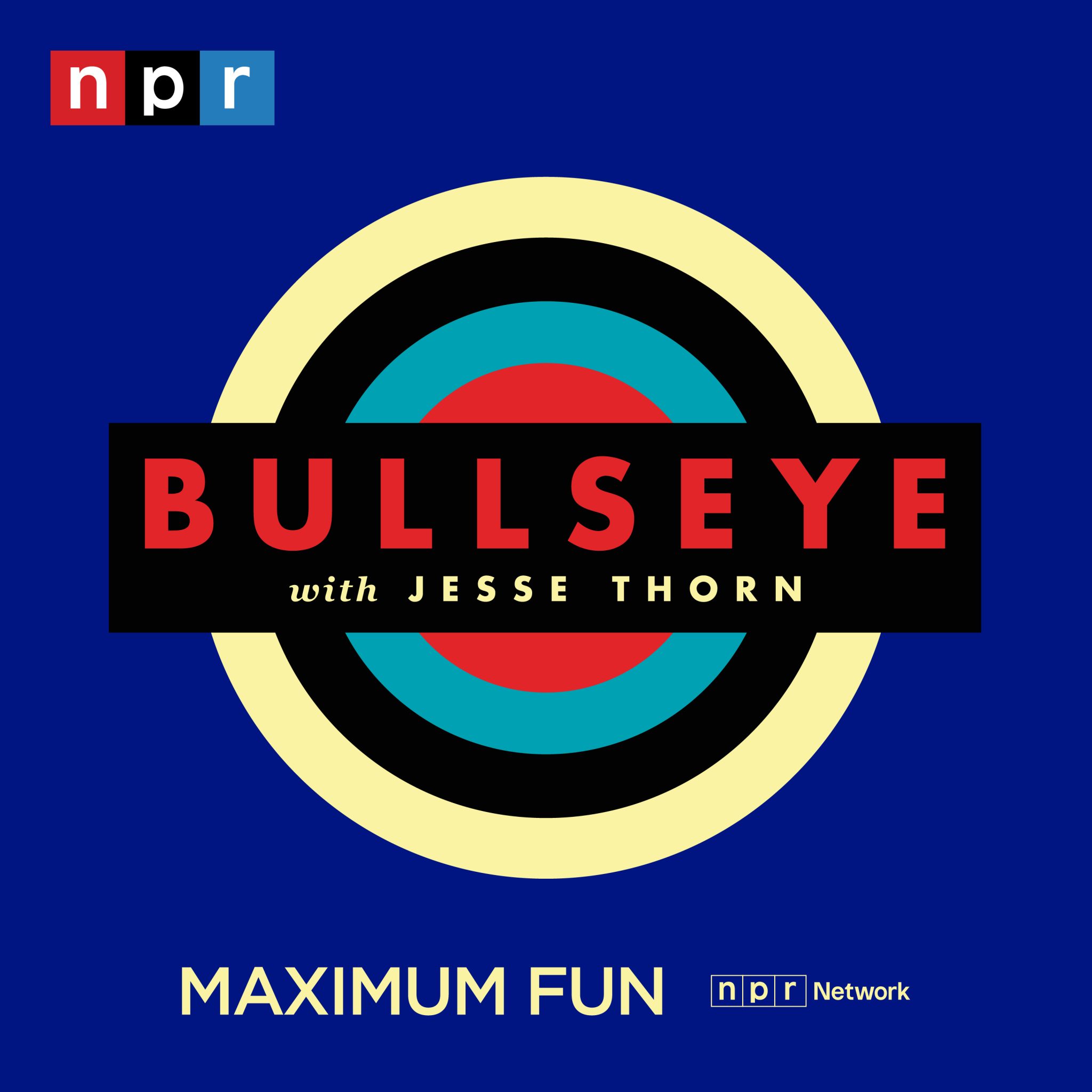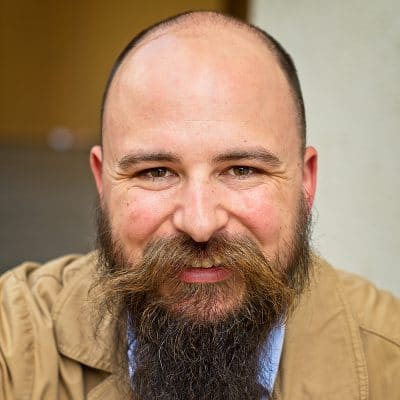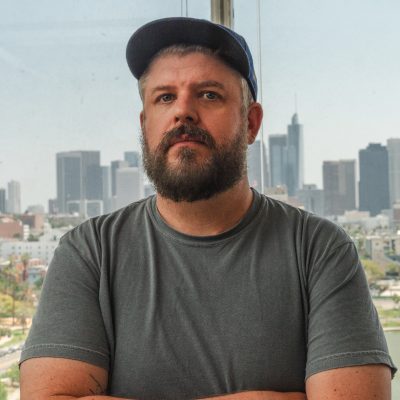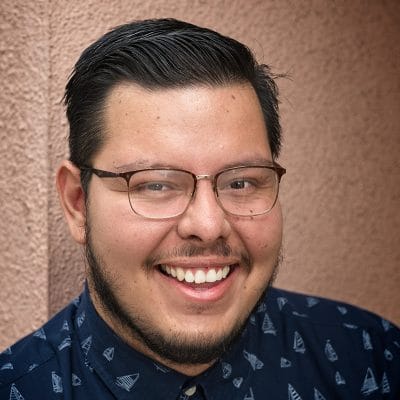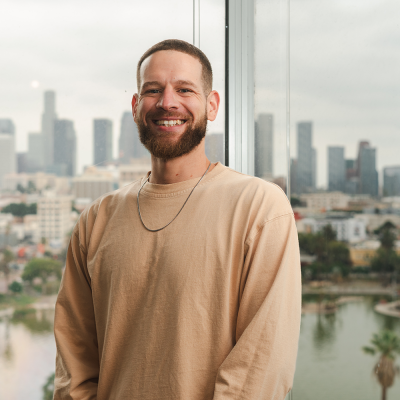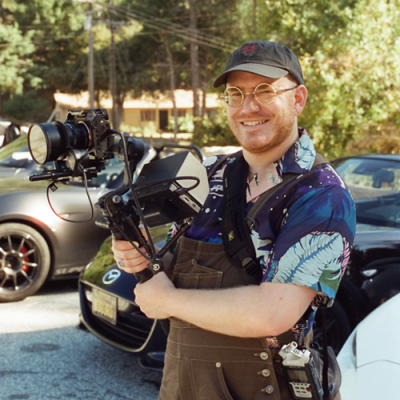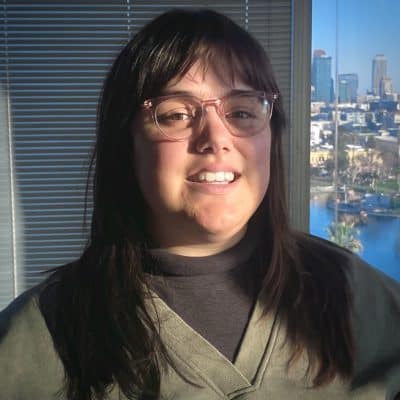Transcript
[00:00:00]
Transition: Gentle, trilling music with a steady drumbeat plays under the dialogue.
Promo: Bullseye with Jesse Thorn is a production of MaximumFun.org and is distributed by NPR.
Music: “Huddle Formation” from the album Thunder, Lightning, Strike by The Go! Team—a fast, upbeat, peppy song. Music plays as Jesse speaks, then fades out.
Jesse Thorn: It’s Bullseye. I’m Jesse Thorn. What does an acoustic guitar do? We’re usually talking about six steel strings; big, hollow body. You go to a folk concert, everybody’s got one. You go to a rock, pop, or R&B show, the singer brings one out when they wanna do something more stripped-down and intimate. That singer usually strums the acoustic guitar. Big, open chords. You don’t often hear a hook or a lick played on an acoustic. Even more rarely do you hear someone shredding on one. The acoustic guitar usually accompanies. Unlike its cousin, the nylon stringed classical guitar, you’ll rarely see someone alone on stage playing a solo on acoustic guitar.
My guest, Hayden Pedigo, wants to change that. When Pedigo plays an acoustic guitar, he doesn’t sing; he doesn’t have a big backing band. He writes sprawling, beautiful songs around the instrument, and swaying, breathtaking. This is “Long Pond Lily”, the opener off his new album I’ll Be Waving as You Drive Away.
Music: “Long Pond Lily” from the album I’ll Be Waving as You Drive Away by Hayden Pedigo, a dreamy tune with cascading chords.
(Music fades out.)
Jesse Thorn: Hayden Pedigo was born and raised in Amarillo, Texas. He even ran for city council there once. He has an affinity for taking his promotional photos while wearing corpse paint. That’s the kind of makeup that you see on the lead singers of death metal bands. We will talk about that, I promise.
Transition: Thumpy synth with light vocalizations.
Jesse Thorn: Hayden, welcome to Bullseye. I’m so happy to have you on the show!
Hayden Pedigo: Glad to be here. Thanks for having me.
Jesse Thorn: So, you are in Oklahoma City, where you live. I can see you through the internet, and you have a guitar on your lap. Would you like to start by playing something from the new record?
Hayden Pedigo: Yeah, absolutely. I’ll play the song “I’ll Be Waving as You Drive Away”. It’s the title track to the new record, and it’s a very special song for me. I’ll play that one.
[00:05:00]
Music: “I’ll Be Waving as You Drive Away” from the album I’ll Be Waving as You Drive Away by Hayden Pedigo, played live in the studio. The tune is thoughtful and unhurried with multiple lines of melody weaving and intertwining throughout.
(Song ends.)
Jesse Thorn: Hayden, that was so beautiful. Thank you.
Hayden Pedigo: Thank you so much. I appreciate it.
Jesse Thorn: You said it’s a really special song to you. Why is that?
Hayden Pedigo: Well, I think for multiple reasons. That title “I’ll Be Waving as You Drive Away”, it comes from a 1978 episode of Little House on the Prairie. I watched that show a lot as a kid. I was homeschooled, and I have a joke that, in the state of Texas, you legally have to watch A Little House on the Prairie to graduate. It’s a part of the curriculum in high school or something. That’s a joke. (Chuckles.) But I watched a lot of that show, and that episode is super emotional and sentimental for me. So, I named that song after that episode.
And the timing of it when I wrote that song, it was interesting. Because I finished that song right around the time I was leaving Amarillo for the final time. Like, Amarillo, Texas is where I grew up; I have a deep emotional attachment to that place. But that song is kind of the soundtrack of leaving home, leaving behind everything you know and you’re comfortable with—including family and friends. So, I think that song makes me think of that feeling every time I play it.
Jesse Thorn: Was part of the appeal of those books to you—as a kid living in Amarillo—that you lived so close to where people barely live? You know what I mean?
Hayden Pedigo: Yeah, I think so. ‘Cause I mean, I grew up in a part of Amarillo called River Road. It’s like outside of city limits, so it’s not technically a part of Amarillo. But it was like out in the country. There wasn’t very many kids around, and I was used to the stillness and the silence. And it was also very lonely. And it’s funny. Still to this day, I have people tell me like, “Your music feels so lonely.” Like, it’s just been a constant theme in my music. And I think those environments and landscapes of like the loneliness of like the American West or something like that—I romanticize it a lot, because it’s something I kind of experienced being a homeschooled kid.
My dad was a pastor at a truck stop growing up. So, it was like a lot of my childhood felt kind of like a book or something.
Jesse Thorn: Where does a pastor operate at a truck stop?
Hayden Pedigo: So, there’s like an organization called like Truck Stop Ministries International. And across the US they have these converted trailers, like 18-wheeler trailers that they’ve planted behind truck stops. Like, in Amarillo, the Petro truck stop has this trailer that—like, they have covers that cover the wheels, but they’ve turned it into a church where it has like vinyl flooring, metal chairs. It probably sits like 15 to 20 people, maybe; it might be less than that. But every Sunday my dad and us would go out there, and he would preach to truckers every Sunday. Because they wanted truck drivers to have access to church. So, they would reach agreements with like the Petro to let them put the trailer there and have a chapel accessible.
So, it was interesting. You met so many different people. You know, as a kid I met so many different people through that, because every Sunday it was a different group.
[00:10:00]
Jesse Thorn: Were there any regular parishioners, or was it people passing through all the time?
Hayden Pedigo: So, there was—weirdly, there was like some people that were really devoted to my dad’s preaching who you would see them like once every two months. Like, my dad had a following amongst truck drivers who were like really big fans of his preaching. So, they would make a point to like pass through and try to make it on a Sunday. But then for the most part, every Sunday was usually new people.
Jesse Thorn: We’ve got more to get into with Hayden Pedigo. Pedigo uses silence in his music frequently. He does it so frequently, in fact, that he has realized that he has to begin shows with a warning: “Don’t start clapping until I look up.” It’s Bullseye (pointed pause) from MaximumFun.org and NPR.
Transition: Thumpy synth with light vocalizations.
Jesse Thorn: This is Bullseye. I’m Jesse Thorn. My guest is Hayden Pedigo. He’s a folk guitarist from Amarillo, Texas. His new album is called I’ll Be Waving as You Drive Away.
When did you start playing music?
Hayden Pedigo: I started playing music when I was around 11 or 12. I remember my mom, she would play a CD of Santana in the car. I feel like the few whole leftovers from my mom’s non-Christian life was like Santana and Van Morrison. And I wanted to play guitar, so my parents put me in just kind of basic guitar lessons. There was a guy in Amarillo named John Farrell. Very, very incredible, sweet, kind person. I have so much respect for him. But he taught me a guitar, just taught me how to play chords and stuff like that. And then I stopped taking guitar lessons at 14, found Leo Kottke and John Fahey and Ry Cooder and all those guitar players, and started to teach myself how to play slide and finger pick.
And the Amarillo Public Library at the time had an incredible collection of CDs you could rent. They’re gone now. But there was like Frank Zappa CDs, Miles Davis CDs, so much cool stuff that just blew my mind. And I remember there was a librarian there—when I was 13, I went up to the counter and asked, “Do you have any good guitar CDs?” And he got me like some actual like deep stuff, like Danny Gatton and Charlie Christian—like, stuff that was like way beyond what a 13-year-old was looking for. But thanks to that librarian.
Years later, I was working at a retail store when I was 18, and that librarian came through. And I was like, “I don’t know if you remember me, but when I was 13, you recommended these CDs to me, and it changed my life.” And he said thank you and left. But I was glad I got the chance to tell him thanks. Librarians do great work.
Jesse Thorn: Do you wanna play another song?
Hayden Pedigo: Yeah, I can definitely do another one. This next one, it’s a song of mine, called “Houndstooth”. It’s another new track from this record, I’ll Be Waving as You Drive Away. But the story behind this one is I wanted to write a perfect John Fahey song. I don’t know if I accomplished that, but it was inspired by him and also this 1950s vocal group called The Platters. They did songs like “Twilight Time” and “Smoke Gets in your Eyes”. My grandfather was really into The Platters, so I heard a lot of that kind of music.
Music: “Houndstooth” from the album I’ll Be Waving as You Drive Away by Hayden Pedigo, played live in the studio—a lilting, meandering melody with frequent pauses.
[00:15:00]
(Song ends.)
Jesse Thorn: Thank you.
Hayden Pedigo: Thank you all.
Jesse Thorn: You said that you wanted to write a perfect John Fahey song. Who’s John Fahey?
Hayden Pedigo: So, John Fahey is a guitar player. He started releasing music in the late 1950s, put out his first record in 1959. But he was a really distinct guitar player, very American guitar player. But he found a way to really meld so many styles. He was like a still-string, finger picking guitarist who pulled from a lot of pre-war blues, country music, Indian music, avant-garde music, classical music. And he found a way to like synthesize all those influences into six strings on the guitar.
And to me, he occupies a similar space of like what Segovia did for the nylon string guitar. I don’t know. He forged a path of making the steel string acoustic guitar a solo concert instrument that wasn’t just for like, you know, playing strummed chords on. He found a way to just expand the horizon of what instrumental acoustic guitar music could be. And I mean, for me and a lot of others, his music is like the gateway to an entire new world.
Jesse Thorn: Did you ever want to be a super technical guitarist? Did you ever think it would be cool to be Joe Satriani or something?
Hayden Pedigo: Yeah, when I was 12, when I first started playing guitar— I was super into Stevie Ray Vaughan and stuff like that at 12. But what ended up happening is my left hand on the fretboard was just not fast enough. I couldn’t shred, and I thought that was it. I thought—I was like, “Okay, you’re not a very gifted guitar player. You should pack it up,” after one year. But luckily, I ended up finding players like Ry Cooder, who played slide, and I started playing with slide and realized like, “Oh, you don’t have to shred. A lot of the magic is in your picking hand, on the right hand.” And I realized I was just approaching it wrong.
And then because of that, it made me just reevaluate how I played guitar. It didn’t have anything to do with technique as much anymore, and it was just purely about the feeling and the stories. And I mean, at the same time, I was getting really into prog rock and stuff like KingCrimson, and Miles Davis with like his electric period, and post punk, and noise. And I was going really crazy in high school, just finding all of this wild music. And I found guitar players like Fred Frith, who—he was putting screwdrivers under the strings and making a bunch of noise—and realizing that like the textures is what I was interested in. So, I was lucky that I found music that made me realize that there was just not as many rules as I thought there was. And music became a lot more fun for me.
[00:20:00]
Jesse Thorn: How do you tell a story in a song without words?
Hayden Pedigo: Well, I think for me it’s the same thing that’s in Fahey’s music. It’s a specific feeling. And it’s all in the touch and in the melody. And when I’m writing a song, I’m just picking around on a guitar in an open tuning, and I’m following something. I don’t know what it is, but I’m just messing around. If I hear something that like perks my ears a bit, I’m like, “Let me follow that for a bit.” It’s just, to me—it sounds sooo (chuckles) head in the sky, kind of silly; but it’s like seeing like a pretty bird outside your window, and like following it, and going, “I wonder how long I could follow this thing and see where it goes.”
And that’s what I do is just like you catch a glimpse of something that’s, you know, a note or a tone or something, and you follow it as long as you can. And sometimes you’re able to catch up with it. Other times you lose it, and you have to put the guitar up for a week or two until it comes back. So, I think if you follow those things, it will tell the story. Because a lot of the times people ask me what a certain song meant. And when I wrote it, I didn’t know what the song meant. It was just purely a feeling. And then a year or two later, I realize what the song meant because of an experience that happens, even afterwards, where I’m like, “Oh, this was that feeling.”
Jesse Thorn: I think being from Amarillo has been so central to your work as an artist, to the point where—I know that for at least a time—that’s how you were opening and closing your shows, by introducing yourself as being from Amarillo. What was it like to leave town? You live only a few hours away now in Oklahoma City.
Hayden Pedigo: Yeah. So, leaving Amarillo was such a specifically strange thing. It’s just like Amarillo had inspired me so much over the years. But I always say the inspiration had an extreme caveat. The inspiration was due to the pushback. Amarillo was not an easy place to be an artist, and it’s challenging. And I found inspiration in the fact that I was the only one doing what I was doing there. And that’s inspiring. And I found inspiration in the fact that, for a long time in Amarillo, I didn’t really have a following there. I didn’t have fans of my music. I don’t think people got it. And I would always joke that’s like—it’s weird; like, on streaming you can see your top 100 cities. And like Paris was on there, but Amarillo wasn’t.
I found it so weird, ’cause my music sounds so much like Amarillo and the landscape, the flatness, the wind, the sunsets, everything. But what’s strange is I was like—I thought people from Amarillo would like this, because it perfectly describes this environment. But I realized with a lot of people from Amarillo is they don’t want to know that they’re from there. There’s like a resentment of like, “I resent that I’m from Amarillo,” where I liked that I was from there. I wore it as a badge of honor of like, “I’m from this place that is not easy; the wind blows all the time; it’s so dry; it can be very lonely.” But I think the most beautiful things come out of that type of environment.
But I had to leave, because there’s this realization for me that you can only find inspiration in pushback and resistance for so long. After a certain point, you can wear yourself out and do harm. And the second I started to feel that, I was like, “Now is the time to leave. I got everything I needed to learn from Amarillo. I feel like I have it.” And now that I’ve left—not even that far away; I’m still fairly close, but it’s not Amarillo. But every single show I play, I say, “My name is Hayden Pedigo, and I’m from Amarillo, Texas.” Because for one, it’s my identity. It’s who I am. And two, it’s me reclaiming this thing.
Amarillo could be hurtful and hard to me at times, but it’s my way of saying, “I’m claiming that as my home too.” And if there are people from Amarillo who are younger than me and wanna be an artist or try something different, they need to see someone else doing it and doing it confidently. And I’m not trying to scrub Amarillo from my backstory.
Jesse Thorn: One of the things that probably people listening on the radio notice even more than me looking at you through the internet is the silences in your music. I heard that those silences were so pronounced in performance that you found yourself explaining them ahead of time, so people don’t applaud at the wrong time.
Hayden Pedigo: Yeah, it was funny. The very first like real tour I ever went on—because I didn’t tour at all, because I worked bank jobs through my 20s, ’cause I was scared of pursuing music. I didn’t think it was realistic. But the first legitimate tour I ever did was opening for Jenny Lewis, who’s incredible. And I agreed to do this tour without thinking if I was capable of doing it.
[00:25:00]
And I went to the first show in Chicago, and it was like a 7,000-capacity room. And there’s no fear like realizing, “Oh.” It was like a feeling of like lying on your job application where you’re like, “Oh, I was like not qualified to be doing this thing.” But I went out and played it, and it went okay. But over those first few shows, I would be playing a song, and I would have a pause, and like the audience would start applauding thinking it was over. And it would like psych me out. And sometimes I would end a song too early, ’cause I didn’t know how to explain there was more to the song. So, I started explaining to the audience up front.
I would say, “My name is Hayden Pedigo. I’m from Amarillo, Texas. A bit of a disclaimer, but my songs have a lot of long, awkward pauses in them. And at times it may seem like the song is ending when it’s not. So, when the song is over, I’ll just say it’s over.” Or something like that. And the audience would laugh and thought it was funny. But I started noticing after I would do that, the audience became a lot more respectful. Because this idea that you don’t know when the ending of the song is coming and there will be pauses, it’s like an audience jumpscare. They’re on edge waiting for the jumpscare. Because there would be times that I would play a long pause, and the room would be silent, and someone would be talking loudly, and they would just stop talking because they felt the spotlight on them.
And I realized that silence and music is a weapon that can be used, because it forces people to be more aware of their surroundings. And as I went, the pauses became longer and longer and longer. And I think it’s maybe, at times, really intense for people, because we’re not used to silence as much anymore, and we’re especially not used to silence in large gatherings of people. And it’s emotional. It feels really intense, feeling silence with a large group of people, because the only time we ever feel that is like a moment of silence in the wake of something bad happening. And I’m like, “Why is it we only take moments of silence in the face of bad things happening?”
It’s like there’s a power in being silent together without a specific reason and in a fun environment. And there’s something—there is like a church fellowship in going to a concert together; there’s this like-mindedness of like, for the most part, “I wanna be here to hear this artist.” And for me, I’m like, “Well, let’s be quiet together,” and it makes you really realize you’re in a room full of people. It’s intense.
Jesse Thorn: We’ll wrap up with guitarist Hayden Pedigo after the break. Back in a minute. It’s Bullseye for MaximumFun.org and NPR.
Promo:
Music: Fun, exciting music.
Allan McLeod: Walkin’ About is the podcast about walking. It’s a walkumentary series where I, Allan McLeod, and a fun, friendly guest go for a walkabout. You’ll learn about interesting people and places and have the kind of conversations you can only have on foot! We’ve got guests like Lauren Lapkus.
Lauren Lapkus: I figured something out about this map, like how to read it.
Allan: Betsy Sodaro.
Betsey Sodaro: I had no clue. That’s awesome and nuts.
Allan: Jon Gabrus.
Jon Gabrus: This is like a great first date for like broke 20-somethings, you know?
Allan: And more! Check out Walkin’ About with Allan McLeod on Maximum Fun.
(Music ends.)
Transition: Thumpy synth with a syncopated beat.
Jesse Thorn: Welcome back to Bullseye. I’m Jesse Thorn. My guest is Hayden Pedigo. He’s a folk musician who was born and raised in Amarillo, Texas. He makes instrumental music—usually just his acoustic guitar, sometimes a couple of other instruments. He just put out a new record. It’s called I’ll Be Waving as You Drive Away. Pedigo brought his guitar by the studio for a live performance in addition to our conversation. You can see video of Hayden’s performance on the Bullseye YouTube page. Just search for Bullseye with Jesse Thorn. Let’s get back into our conversation.
Do you wanna play another piece for us?
Hayden Pedigo: Yeah, I think I might try playing an old tune that actually I haven’t played in a while. It’s an old one called “Carthage”. I wrote it a few years ago. It was on a record of mine called Letting Go. But I haven’t played it in a long time, and I wanted to revisit it. So, if it’s cool with y’all, I’m gonna play an old one.
Jesse Thorn: Please. Thank you.
Music: “Carthage” from the album Letting Go by Hayden Pedigo, played live in the studio—a hopeful, winding melody with a steady build and poignant pauses.
[00:30:00]
(Song ends.)
Jesse Thorn: Hayden Pedigo, that’s so beautiful. Thank you.
Hayden Pedigo: Thank you so much. I appreciate it.
Jesse Thorn: This isn’t something I say to a lot of guests on the show, but you’re a big corpse paint guy.
Hayden Pedigo: Yeah.
Jesse Thorn: I mean, first of all—(laughs) first of all, for the folks who are listening on their local public radio stations they just happened to leave the radio on after marketplace ended—maybe you could explain what corpse paint is.
Hayden Pedigo: Yeah, so corpse paint, it’s like a style of face paint that a lot of black metal bands wear. Black metal’s like a strange sub-genre of metal music. It’s very like shrill, harsh, a lot of treble, screams that sound like whispers. Anyways, they wear a style of face paint. Not all of them, but it’s pretty associated with black metal. But they wear a style of face paint that, for those who are maybe older and don’t know much about metal, the closest thing I could compare it to is like the face paint Kiss wore. It doesn’t look like that, but it does kind of look like that. Just so you all have a reference point.
Jesse Thorn: It’s like a more intense version of that.
[00:35:00]
Hayden Pedigo: Yes, it’s like a way more intense version of the Kiss face paint. But I had an album called Letting Go that, on the cover, there’s a painting of me wearing this black metal face paint standing in front of an 18-wheeler—a red semi-truck. And it was based on a real photo of me. It was actually a real photo of me wearing corpse paint in front of the semi in Lubbock, Texas.
Jesse Thorn: Tell me what the appeal is for you. I mean, I’m gonna be honest with you, Hayden. There are some thematic resonances in a dude whose dad was a truck stop preacher wearing death metal face paint in front of a tractor trailer. (Chuckles.)
Hayden Pedigo: Well, it’s funny, because the album’s called Letting Go, and I had this idea— What’s funny is like the painting of me wearing the corpse paint, I look kind of sad. And it—to me, it looked almost like this character on the cover is like a black metal fan who’s driving a truck for a living, but ultimately is not living out their true life’s purpose. And the title is Letting Go. So, I mean, it could mean so many different things.
But I liked that imagery of someone wearing the face paint, doing this normal job like trucking but looking kind of sad or disappointed or confused. And I also liked the idea of this album cover, because the album’s like very sweet and sentimental. Like, the song I just played is from the record Letting Go. And I like the idea of people seeing the cover and having one idea of what the record would sound like, and then they would put it on, and they would feel like, “Oh, this is so entirely different than what I was expecting.”
Jesse Thorn: I like the idea that you’re this crossover artist between people who are listening to Scandinavian black metal and then Arts Performance Series subscribers who enjoy acoustic guitar music.
Hayden Pedigo: Yeah. Well, I think this leads to like a way bigger point, but I talk about it a lot that I’ve had people say to me that like John Fahey style American primitive—that’s what they call it—like, American primitive guitar music is like niche. Like, it can only have a niche audience. But I’ve always been confused, because I feel like the music I play—I feel like most people could listen to this. And that’s why I’ve had like metal fans come to my show, older people come to my show. Every kind of person is like, “I’m really into this.”
But if you think about it, it’s like, why would you not be into this? I’m not saying it like my music is just that good; it should blow people away. I just mean it like it’s sentimental and melodic. It’s not showy. And I think it can be a bigger kind of music than people give it credit. I just think people don’t know yet that they might like this kind of music. They’ve just never checked it out. And I’ve had a lot of people say, “I’ve never listened to this kind of music before, but I’m really into it now that I’ve heard your stuff.”
And I don’t know; I want people to realize that this kind of music is far more approachable than they think. It’s not like this niche, avant-garde thing. But I do tend to write a more melodic-style that I think a lot of people could get into. But black metal fans, I think, are into what I do because there’s like a proggy-ness to some of my songs in the 12th string that can feel like an interlude on a black metal album. So, I think that’s where the crossover can be.
Jesse Thorn: Hayden Pedigo, I’m sure grateful for your time. It’s so nice to get to talk to you and get to know you.
Hayden Pedigo: Great to be here. I appreciate y’all letting me play some songs and talk. This has been cool.
Jesse Thorn: Hayden Pedigo. As we mentioned earlier, his new album I’ll Be Waving as You Drive Away is available to buy or stream now. It’s very beautiful. If you’d like to see him live, he’ll be touring all over the world from late summer into early fall. We’ll have a link to dates on the Bullseye page at MaximumFun.org.
Transition: Bright, chiming synth.
Jesse Thorn: That’s the end of another episode of Bullseye. Bullseye is created from the homes of me and the staff of Maximum Fun—as well as at Maximum Fun HQ overlooking beautiful MacArthur Park in Los Angeles, California. You may have heard MacArthur Park in the news. Maybe you even thought of us. I was actually in the studio the other day when the park filled with military vehicles and what turned out to be federal law enforcement personnel, including ones riding horses. The park was very quiet. It was mid-morning. And to see vehicles that looked like tanks—I don’t know what tanks with tires are called; armored personnel carriers? But to see military-looking law enforcement personnel fill up the park in front of our office was genuinely terrifying, and I wouldn’t wish it on anyone.
Our show is produced by speaking into microphones. Our senior producer is Kevin Ferguson. Our producers are Jesus Ambrosio and Richard Robey. Our production fellow at Maximum Fun is Hannah Moroz. Our video producer is Daniel Speer.
Special thanks this week to Gilson Machtolff at 33rd Street Studios in Oklahoma City for recording audio of our interview and performance with Hayden Pedigo.
[00:40:00]
And to videographer Lauren Bumgarner for catching it on camera.
We get booking help on Bullseye from Mara Davis. Our interstitial music comes from our friend Dan Wally. He’s also called DJW. In fact, you can even download music from this show. Pay what you want at DJWsounds.bandcamp.com. Our theme music was written and recorded by The Go! Team. It’s called “Huddle Formation”. Thanks to The Go! Team. Thanks to their label, Memphis Industries.
You can follow Bullseye on Instagram, TikTok, and YouTube, where you’ll find video from just about all our interviews—including the ones you heard this week. And I think that’s about it. Just remember, all great radio hosts have a signature signoff.
Promo: Bullseye with Jesse Thorn is a production of MaximumFun.org and is distributed by NPR.
(Music fades out.)
About the show
Bullseye is a celebration of the best of arts and culture in public radio form. Host Jesse Thorn sifts the wheat from the chaff to bring you in-depth interviews with the most revered and revolutionary minds in our culture.
Bullseye has been featured in Time, The New York Times, GQ and McSweeney’s, which called it “the kind of show people listen to in a more perfect world.” Since April 2013, the show has been distributed by NPR.
If you would like to pitch a guest for Bullseye, please CLICK HERE. You can also follow Bullseye on Twitter, YouTube, and Facebook. For more about Bullseye and to see a list of stations that carry it, please click here.
Get in touch with the show
People
How to listen
Stream or download episodes directly from our website, or listen via your favorite podcatcher!
